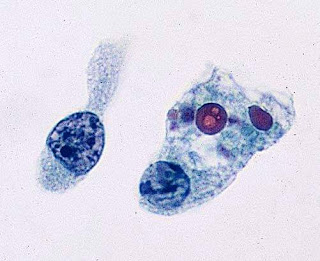Verrucous squamous cell carcinoma
Histopathology of Verrucous squamous cell carcinoma:
In all cases a well-differentiated proliferative epithelial process is visible, the malignant nature of which may easily be overlooked, particularly if the biopsy is small and superficial. The squamous epithelium shows an asymmetric exo andn endophytic growth pattern with pushing rather than destructive or infiltrative margins. Usually, there is deep penetration below the level of the surrounding epidermis / mucosa. Tumour cells exhibit only minimal atypia and very low mitotic activity. The presence of neutrophils is an important diagnostic clue; they may form small intraepidermal
abscesses. Draining sinuses containing inflammatory cells and keratin debris may also be present. No foci of the usual squamous cell carcinoma should be found.
Differential diagnosis:
The separation from benign reactive processes and SCC of the more usual type can be difficult. The presence of blunted projections of squamous epithelium in the mid and/or deep dermis is suspicious for verrucous carcinoma. The squamous downgrowths are bulbous. Small collections of neutrophils may
extend into the tips. Clinicopathological correlation and adequate sampling are often helpful.
In all cases a well-differentiated proliferative epithelial process is visible, the malignant nature of which may easily be overlooked, particularly if the biopsy is small and superficial. The squamous epithelium shows an asymmetric exo andn endophytic growth pattern with pushing rather than destructive or infiltrative margins. Usually, there is deep penetration below the level of the surrounding epidermis / mucosa. Tumour cells exhibit only minimal atypia and very low mitotic activity. The presence of neutrophils is an important diagnostic clue; they may form small intraepidermal
abscesses. Draining sinuses containing inflammatory cells and keratin debris may also be present. No foci of the usual squamous cell carcinoma should be found.
Differential diagnosis:
The separation from benign reactive processes and SCC of the more usual type can be difficult. The presence of blunted projections of squamous epithelium in the mid and/or deep dermis is suspicious for verrucous carcinoma. The squamous downgrowths are bulbous. Small collections of neutrophils may
extend into the tips. Clinicopathological correlation and adequate sampling are often helpful.



Comments
Post a Comment
Thank you for posting your comment.Your question will be answered soon.